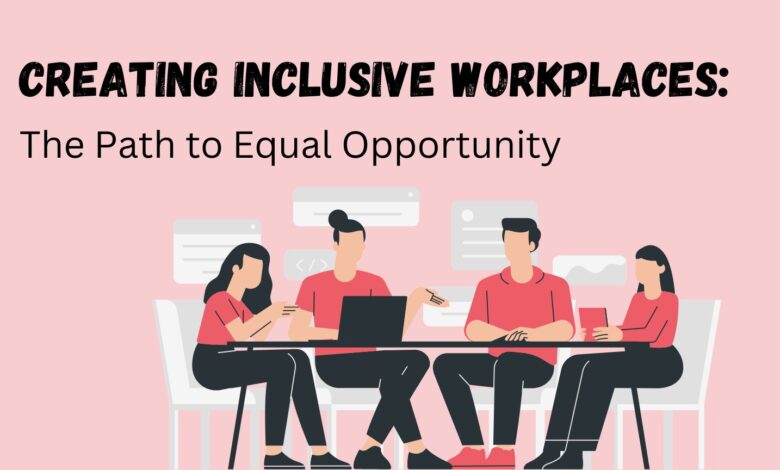Creating Inclusive Workplaces: The Path to Equal Opportunity

In today’s evolving global landscape, the drive for equal opportunity and inclusivity in the workplace is stronger than ever. Despite significant progress, challenges like gender inequality in India and gender equality in the workplace remain critical topics that require attention. While these issues are global, each region faces unique cultural, economic, and social barriers that can hinder progress. In this blog, we’ll explore how businesses can create more inclusive environments, benefiting not just employees, but the organizations themselves.
Why Inclusivity Matters in the Modern Workplace
Creating an inclusive work environment isn’t just a moral responsibility—it also has tangible benefits. Companies that embrace inclusivity foster creativity, increase employee satisfaction, and improve overall performance. Employees who feel respected and valued are more likely to contribute meaningfully, and diversity leads to better decision-making by bringing in varied perspectives.
When companies prioritize inclusivity, they attract top talent from diverse backgrounds, strengthening their workforce and building a more innovative team. As a result, gender equality in the workplace becomes a driving force behind a company’s success.
Addressing Gender Inequality in India: A Long Road Ahead
Gender inequality in India remains a persistent issue, particularly in rural areas, where cultural norms often limit opportunities for women. Despite educational advancements and various governmental initiatives, many women still face barriers to economic independence, leadership roles, and fair wages. Addressing these inequalities in the workplace is crucial for empowering women and ensuring they can contribute fully to society and the economy.
Programs that focus on women’s skill development, leadership training, and workplace flexibility can help bridge the gender gap in India. In addition, businesses must take responsibility for fostering an environment that supports gender equality, making equal opportunity a cornerstone of their policies.
Building Policies that Promote Equality
The foundation of an inclusive workplace starts with clear and effective policies that support gender equality. Organizations must develop comprehensive policies that eliminate bias in recruitment, promotions, and pay structures. These policies should ensure that all employees—regardless of gender—have equal access to opportunities for career growth and professional development.
It’s also important for companies to establish transparent reporting mechanisms where employees can voice concerns about discrimination or unequal treatment without fear of retaliation. Regular training programs on diversity, equity, and inclusion (DEI) can further reinforce the importance of these policies and educate employees on unconscious biases that may influence workplace dynamics.
Read Also>>> How Virtual Classrooms Are Changing Traditional Education
Promoting Equal Pay for Equal Work
One of the most visible manifestations of gender inequality in the workplace is the wage gap. Globally, women earn less than men for the same work, and the disparity is even more pronounced in countries like India. Ensuring equal pay for equal work is a critical step toward achieving gender equality.
Businesses must conduct regular pay audits to assess disparities and adjust compensation accordingly. By making salaries transparent and holding leadership accountable for closing the wage gap, organizations can move toward a fairer, more equitable workplace. This, in turn, boosts employee morale and reduces turnover rates.
Encouraging Women in Leadership Roles
Despite a growing focus on gender equality, women remain underrepresented in leadership positions worldwide. Encouraging women to take on leadership roles within companies is essential to fostering an inclusive work environment. Mentorship programs, leadership development training, and flexible working conditions can help women climb the corporate ladder.
Creating platforms where women can network and share experiences with others who have successfully navigated their careers is another effective strategy. By promoting women into decision-making positions, companies can inspire others and ensure that different perspectives are represented at the highest levels.
Flexibility and Work-Life Balance
One of the most significant barriers to gender equality in the workplace is the lack of work-life balance, especially for women who are often primary caregivers. To foster an inclusive environment, organizations need to offer flexible work options that accommodate different needs.
This might include remote work opportunities, flexible hours, or job-sharing arrangements that allow both men and women to manage family responsibilities while pursuing their careers. Offering parental leave for both men and women is also crucial in breaking down traditional gender roles and creating a more equal playing field.
Creating a Culture of Accountability
Inclusivity must extend beyond policies—it must become part of a company’s culture. Leaders must take an active role in promoting gender equality by setting clear expectations for behavior and holding everyone accountable for fostering a respectful and inclusive work environment.
Celebrating successes in diversity and inclusion, sharing stories of women who have advanced in the workplace, and promoting internal recognition for efforts that support equality can help shape this culture. Additionally, leadership should continuously assess and adjust strategies to ensure that progress is being made in closing gender gaps.
Read Also>>> Why Real-World Experience is Essential in Truck Driving Education
The Role of Male Allies
While much of the focus on gender equality naturally centers around empowering women, men play an equally important role in promoting inclusivity. Male allies can be advocates for gender equality by challenging stereotypes, supporting female colleagues, and promoting policies that create a more inclusive environment.
When men take an active role in advocating for equality, it helps normalize the idea that both genders benefit from a more inclusive and fair workplace. Male leaders, in particular, can set an example by mentoring women and pushing for systemic changes that ensure equal opportunities for all.
Conclusion: A Collective Effort for Lasting Change
Creating an inclusive workplace where gender equality thrives is a collective effort that requires the participation of every employee, from entry-level workers to top management. While tackling issues like gender inequality in India may seem like a daunting task, meaningful progress can be made through sustained efforts at both the policy and cultural levels.
By developing policies that promote equality, encouraging women in leadership roles, and ensuring equal pay for equal work, businesses can make lasting changes. Companies that foster inclusivity and address gender disparities will not only contribute to a more equitable society but also benefit from a stronger, more diverse, and innovative workforce.
True equality in the workplace is not just about compliance—it’s about creating environments where everyone can thrive, regardless of gender.




